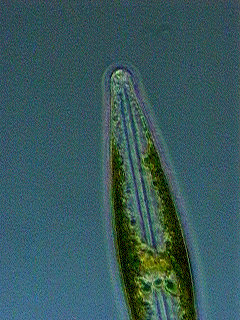More on Raphes
The raphe is one or two lateral slits along side the sternum of the diatom shell. The raphe extends to cover a whole side of the shell initially, but during valve formation it may be altered. The change may split a single raphe into two raphes. The double raphe is separated by a silica bridge (rib) named the central nodule. The raphe may extend from pole to pole or may be incorporated into a different axis. Raphes are supported by cross-linked bridges of silica termed fibulae. Some types of fibulae form canals beneath the raphe and are thus termed "canal raphes." Motility is the major function of the raphe. There are several ideas on the nature of diatom locomotion. It is known that a polysaccharide is excreted from the raphe slits. The first proposal for the movement is that small flagella propel the diatom along the ejected mucilage. Another idea is that the ooze increases the flow of the lipid coated underbody. The substratum (cell w/o the valves) attaches to the secretion by filaments of acid mucopolysaccharide and shortens like a primitive muscle tissue. It is presumed that there are ATPase and protein in the transmembrane structure.
